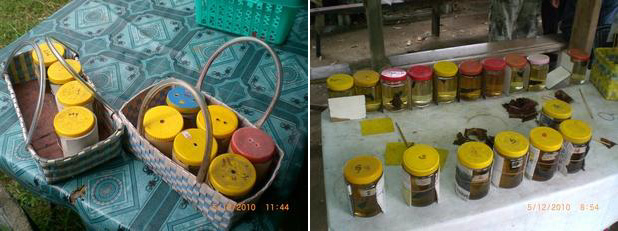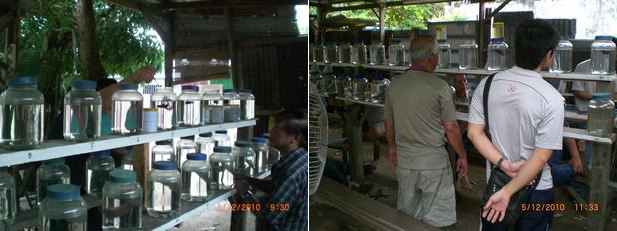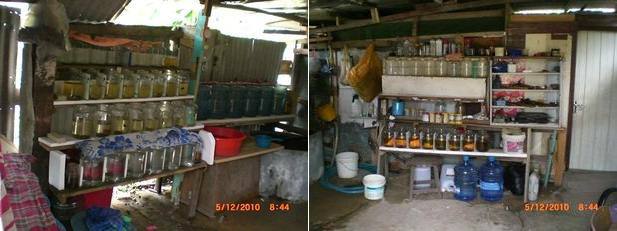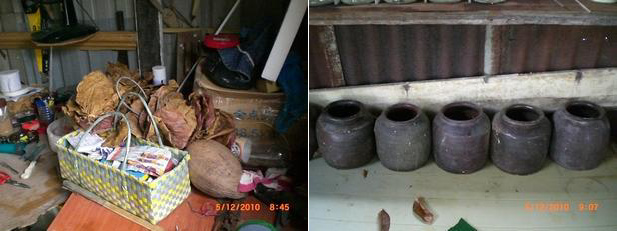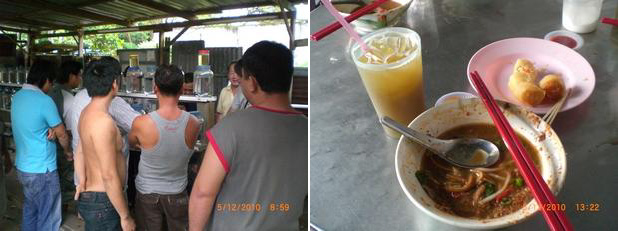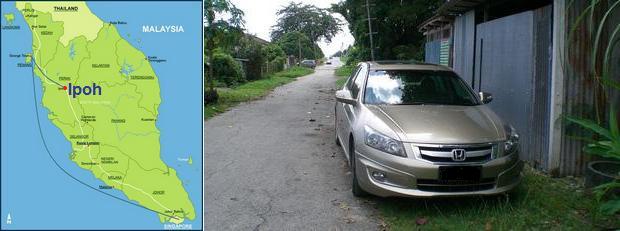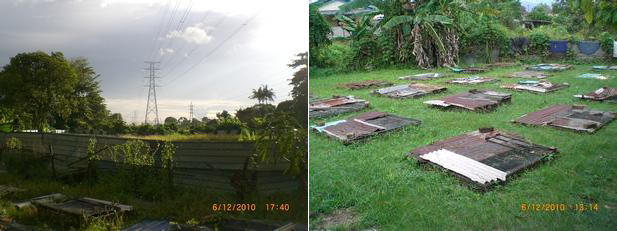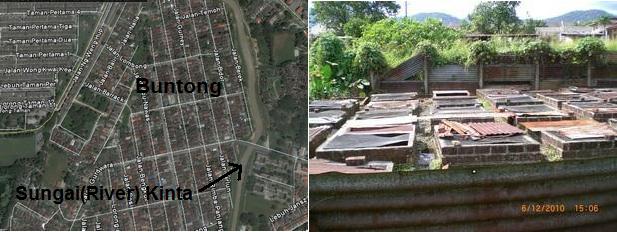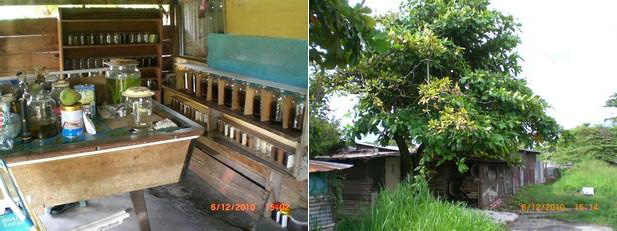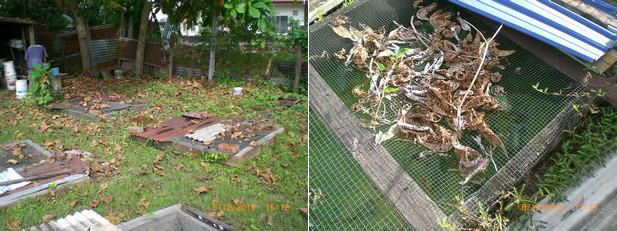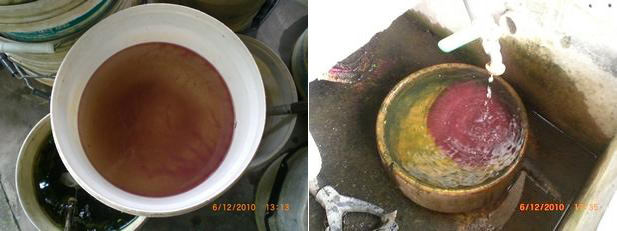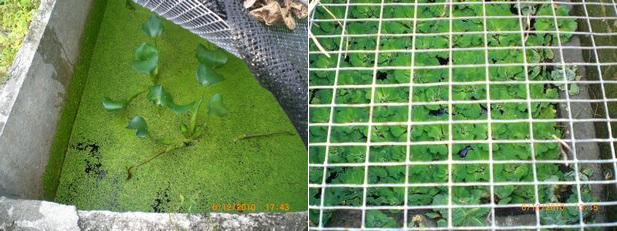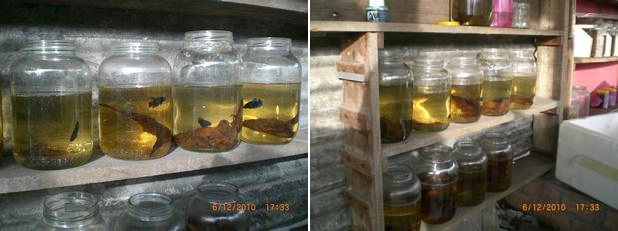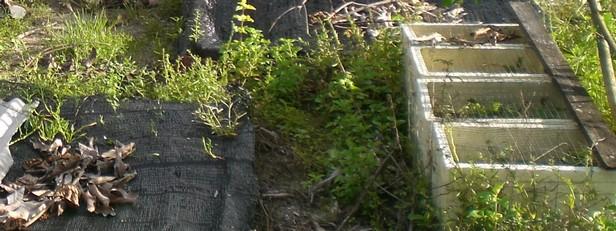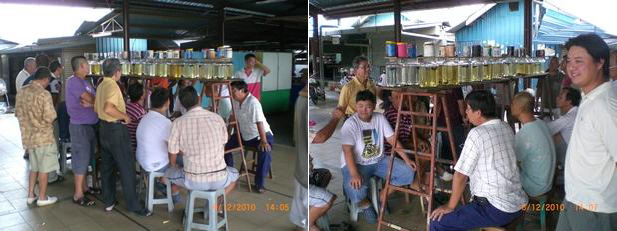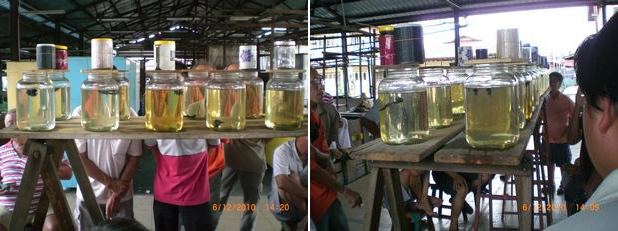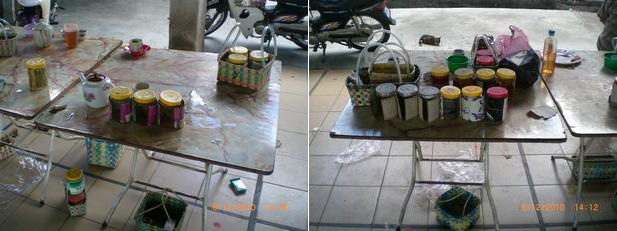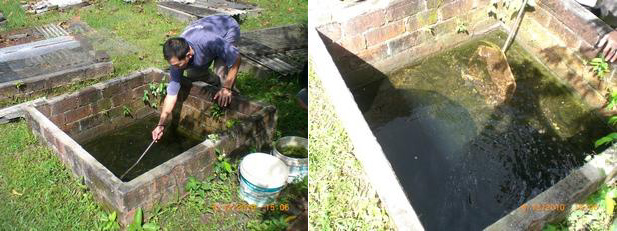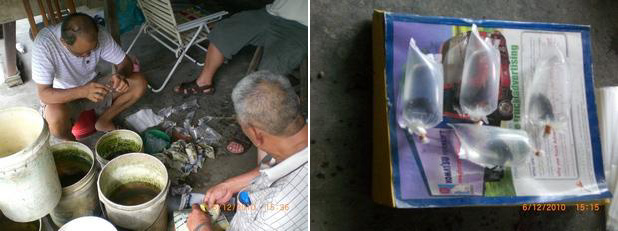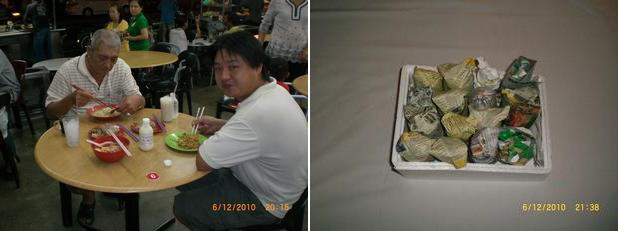
Home of the HardScales
By Redhillbetta :
Malaysia has a history of Betta fighting stretching back centuries. The Bettas used for fighting in the early years were local Betta Imbellis, then widely distributed in ditches and streams. They make crude fighters after several days of isolation with fights that are short and unpredictable, enough as a form of entertainment for some, as well as for a wager for the others. The Plakat Lukmorh(Betta Splendens) fighting strains from Thailand were introduced into the country after the Second World War. These newcomers were superior fighters and they eventually replaced the Betta Imbellis as the de factor fighters at the betta fighting rings. Modern Malaysian fighting strain Bettas are derived from these Plakat Lukmorhs. After half a century of selective breeding and experience in raising them, Malaysian fighting strain Bettas have carved a name for itself as one of the toughest and enduring fighters in the business. My quest for the Malaysian Champion brings me first to Penang and then to Ipoh, join me and my friend MarkT (from Penang) in this journey. I hope you enjoy the sights and information that this web page provides and helps in the learning of the fighting strains Bettas of Malaysia. Some references to betta fighting in Singapore is made when there is a need to draw comparison.
|
|
I first travel to Penang to meet MarkT, a friend of mine of many years, who share the same passion in Bettas. He has kept all sorts of Bettas, from wild types to display and fighting strain Bettas and has been in this hobby since his childhood days. MarkT helps run a family business, but his passion for bettas brings him into contact with the fighting strains and started his involvement in betta fighting, perhaps as a sideline initially, but then became swept up in the challenges and glories of the betta fighting ring. He is now a regular player in Penang, with excellent knowledge in the game and connections with breeders and players alike, anyone who have an addiction to fighting strains knowledge and appreciation like me will find him helpful indeed. |
|
Penang is located in the north west of Peninsula Malaysia, consisting of Penang Island and part of the mainland. It borders the states of Kedah and Perak and is one of the most industrialized states, attracting much direct foreign investments for the country. It is one of the states that has a large Chinese population, many of the ethnic Chinese are into business and trades. Betta fighting activities historically has been in the domain of the Chinese, be it in gambling or in breeding and training them for fights. In fact for locations with a large Chinese population there will be betta fighting and it's related activities and the breeding axis is along the North-South highway, in Penang-Kedah, Ipoh(Perak), Kuala Lumpur(Capital City) and Johor Bahru(Johor). Singapore who shares a common colonial past with Malaysia mirrors the phenomenon, it was once a popular game among it's Chinese population too. With rapid industrialization and urbanization, the game in Singapore up to the 1990s has waned significantly since. The game is in the wane now for many reasons but so because of the basic changes in our societies, these have also affected Malaysia but to a lesser extent at the moment. The Betta fighters in Singapore carries their fighters in "toolbox" bags and keep their fish in "horlicks" (-a beverage) bottles while their Malaysian counterparts prefer a simple rattan woven basket and "tau chio" bottles. The "horlicks" and "tau chio" bottles generally are about 8cm in diameter and the latter have a much bigger cap, making sizing from the top easier. In Penang, they size their fighters from the top and sides like in Singapore, no difference here. |
|
Sizing is an art, the point is one should not give the opponents the advantage of using a bigger fish then yours. Bettas come in different dimensions, some are thicker, others taller, head and body ratios and together with the length of the fish,are taken into account during sizing, it is rather complicated and do require experience and time to master. Picture on the left shows MarkT sizing his fighters with a Kedah player from the mainland. Once the sizing is done, the bettas are paired and placed on the side and on top of the fight bottles respectively, the netting of the bettas into the fight bottles will be done by the players themselves and are witnessed by both party. |
|
The bettas are netted into the fight bottles and not by pouring, a practice similar to the Thais, and the fight bottles are placed on three racks on two different heights, players either stand or sit to watch the fights. Players come from across the country, though Kedah and Penang mainland players are regulars, on this day a Kuala Lumpur(K.L) player is here with his fighters. Bringing with him some top notch K.L bred fighters and having traveled several hundred kilometers certainly is no hobbyist player and stakes are high. In Singapore the players are mix, some fight bettas as an entertainment, some out of a tradition and the rest for a wager. In Penang, I do feel they lean more towards the gambling aspect and less towards recreation. Players here have their own connections, generally the Kedah players source their fighters from their state, but they may also source from Southern Thailand as Kedah shares a common border with southern Thai provinces like the Songkhla and the Yala. The Penang players rely on fighters from Perak, with Ipoh fighters their preferred choice. |
|
A betta training and conditioning shed located beside the Penang betta fighting ring. It is owned by some of the players, in it there are large bottles which seem like they are for "betta chasing" exercises and some smaller round bottles most likely for "water swirling" work. Players have their own ways to train their fighters, their own training set up and regimes but one thing is certain however is that training is not a chore but the foundation for success. There are no sign of betta farms around, in fact there are very few such farms on the island, most of them are located on the mainland. The problem may be similar to Singapore's, whereby there are little or no agricultural activities on the island, the culture of live betta food like moina(water fleas), bloodworms and tubifex worms all require animal waste product, the farming of these fish food can only be done in locations with animal husbandry. It is not cost effective to breed and raise bettas on the island, besides the land on the island itself is one of the most expensive in the whole of Malaysia, very likely will be used for urban development eventually. |
|
Indian Almond leaves(IAL) dried and ready. IAL solution is used to "soften" the water, lowering it's PH level and doubles as a biocides, it's other mythical properties like hardening the fighters' scales also found it's believers here too. The tea colored IAL solution is humid acid released by the dried leaves, with the humid acid, a substance called tannins will form in the water, it is the tannins that players beleive will harden the scales of the fish, giving them a coat of rock hard scales. IAL solution is something magical and their uses seem limitless, all players across nationality swear by it, it also has a calming effect and helps reduce stress on the fighters, helpful during training when the fish have to withstand the rigor of training both physically and mentally. In Singapore, players are more experimentative, dried banana and papaya leaves are also used beside IAL. Clay pots are used to condition the fighters, not a common practice in Singapore, except for some old players. Glass bottles are the most popular and a few may have used Plastic bottles too since they won't break :) |
|
Betta fighting in Penang first started with Betta Imbellis fights, these bettas were caught locally. The Imbellis are called "XioParHur"(打架鱼) or fighting fish, the game eventually evolved to include the Plakat Lukmorhs(Betta Splendens) from Thailand which were introduced into the island after the Second World War. The Plakat Lukmorhs or "SiemHur"(暹罗鱼- Thai Fish) locally called,are better fighters who will fight longer and harder and are heavily built. They eventually replaced the Imbellis in the fighting rings in Penang. Incidentally, the name "SiemHur" (暹罗鱼) orThai Fish back in the 1970s in Singapore were used to refer to the long tailed display/show bettas which at the time were the veil tails. "XioParHur"(打架鱼) or fighting fish (some see all short tailed fighters as such), were locally bred fighters derived from Thai Plakat Lukmorhs(Betta Splendens). In the 1950s, it was said that Thai fighting strains(Betta Splendens) were brought into the aquarium shops and sold at a reasonable price, the better ones may be imported separately and privately at a good price by the rich, it was a novelty to own fighters. During this time, Imbellis was fought in Singapore and they were wild caught, pretty similar to Malaysia's situation, but this Imbellis are called OrKimHur(黑金鱼) or black gold fish. The Thai Plakat Lukmorhs(Betta Splendens) were called "SamJiKork"(三枝角) or Triangular Head. The Thai Plakat Lukmorhs when they first arrived probably gave Singaporean a deep impression of their large jaws which form the head in a triangular shape when viewed from the top and thus the name "SamJiKork"(三枝角) and not to mention their excellent fighting prowess. They were then bred in large numbers and they replaced the Imbellis very quickly and completely at the rings and are simply called "XioParHur"(打架鱼) or fighting fish from then on. The speed in which Singapore bred this Thai Plakat Lukmorhs in large numbers in a short time play a part I think, and it may came from the burgeoning tropical ornamental fish farming business. The climate and weather allows for breeding whole year round and fish ponds were everywhere. The escape of foreign captive fishes like the Guppy for example, into the wild may have also caused the wild bettas'(OrKimHur黑金鱼) population to decline as they could not compete with them, I personally have not seen a OrKimHur(黑金鱼). I remember we were once the Guppy capital of the world. Time have certainly changed and nobody in Singapore use the term "SiemHur" (暹罗鱼) or Thai fish to refer to display/show bettas anymore and they are simply called "Bettas" for example "Halfmoon Bettas", short tailed display/show bettas are called "Plakats" and fighting strains are usually mentioned as "Traditional Plakats". However if you are still not confuse enough the betta fighting players here called Thailand imported fighting strain bettas(Plakat Lukmorhs) as "SiemHur" (暹罗鱼) or Thai fish. The problem and confusion with the naming of the fish arises I think from the fact that the show/display bettas hobbyists ignore the existence of the betta fighting players and the betta fighting players see all show/display bettas as bad fighters and they don't care. They are 2 opposing camps, keeping bettas and fighting them are two different things and they should remain separate. In other parts of Malaysia at the time, Plakat Lukmorhs(Betta Splenden) were bred and raised, which eventually after decades of selective breeding formed the backbone of the modern Malaysian fighting strain Bettas. In the early years, where transportation was poor, many bettas breeding centers bred their fighters for use locally and overtime formed localized populations and many evolved to inherit different traits. The traits for which the Malaysian fighting strain Bettas are well known, are their strong scales, a breed with tough body armour coupled with a stubborn character. During the transition from Imbellis to Splendens fights in Penang, there were also other hybrids fights, like the "Berliao" which is an Imbellis and Splendens cross. Due to rampant gambling, stakes were raised and the "Som" cross came into the scene. The "Som" are also Imbellis and Splendens cross but they are bred to look like an Imbellis and used by cheats to compete in Imbellis fights to gain an unfair advantage, as their hidden Splenden(Lukmorh) bloodlines make them a better fighter. Now the transition from Imbellis to Splendens is complete and only the best of breeds compete in the betta fighting rings.Many modern Malaysian fighting strains nowadays are crossbred, careful selective breeding with fighting strain bettas from neighboring countries are common, all in an effort to make them a better and all rounded fighter. A typical match in the Penang rings is about 3 to 5 hrs, similar to Singapore. The only exception is should there be a tie after the stipulated time, police fish will be used to decide the game. When the combating fish stopped flaring, it will be "tested" by the police fish and will need to take in atmospheric air before the 3rd hit from the police fish. The rule of using police fish in Penang is rather unique in that it does not require the "test" fish to flare or attack the police fish as in Ipoh's ring but to breath atmospheric air. All the fighting rings which I visited be it in Thailand or Malaysia uses police fish, the rules of using them are different in different rings. The exception is Singapore, which does not use police fish at all and more matches do end in a tie. After the whole morning in the fighting ring, we were hungry by noon when the games were ending too. There are many "Kopitiiam", small little "coffee" shops with food stalls selling cheap and good eats. Me and MarkT had Penang Assam Laksa for lunch, accompanied with fried spring rolls which goes really well with the Laksa soup when dipped into them and washed down with a cup of sweet icy sugar cane drink. Yummy |
|
MarkT sought for his fighters in Ipoh, the capital city of the state of Perak located 180km south east of Penang. It is an old mining town with 70% of the people of Chinese origin, and the fighting strain bettas here is known to be the best in Malaysia. In Singapore's betta fighting rings, there is a believe that 40% of champions hail from here and here I am in Ipoh where the fighters that enjoy great esteem for it's toughness and stubbornness are born and raised. The breeding areas are located around Buntong, Chemor and Menglembu. Ipoh being a tin mining town once before, sits on a piece of land with plenty of mineral wealth. The underground water is used to raise bettas and the water quality is said to be "hard" with a high Ph, more alkaline then usual and are high in minerals and nutrients which help promotes strong scales and bone growth in fry. The bettas is also said to mature earlier and are ready as fighters at 6 months instead of the usual 9 months in Thailand. Ask anyone why the bettas are so successful and you are likely to hear that the underground water available contains nutrients and not just beneficial to the bettas but to the vegetable farmers too, their bean sprouts are exceptionally thick and crunchy. |
|
The people in Ipoh is a hardworking lot, full of ingenuity and full of entrepreneurship, many of the vacant lands are converted into farming or for other profit making businesses. Many of the land below the high tension electrical cables which are not used for housing, are all but occupied by the residents and transformed for other uses. It is below these high tension power cables that the residents raised their bettas. The landscape is one with high tension electrical cables and their supporting towers and below them, rows of vegetables plots and columns of fish ponds doted around. With the mining industry long gone, many people have left for the bigger cities like Singapore and Kuala Lumpur to find work, those that stayed behind will have to work on the land, and with perseverance they have made the land into a place for arguably the best fighting bettas there is in the country and create an industry raising and selling them. |
|
Ipoh the city itself was built on tin mining, it's rich mineral deposits attracted early settlers to work in the mines, and eventually formed one of the largest and wealthiest community in the country. The city is built in the rich tin bearing valley of the Kinta Valley and is surrounded by limestone hills. These hills have prevented the landing of large jet aircraft, limiting the growth and development of the city. The main economic activity after the closure of the mines, seem to be resting on manufacturing operations set up by foreign companies and some possible high tech ventures initiated by the government. But other kind of activities are thriving beside the Kinta River, in recent years Ipoh has become the nerve center of fighting strains bettas breeding, the resilience of it's people typify the type of fighters they raise. Buntong and Menglembu are two examples of betta farms located beside the Kinta River(Sungai). Both locations have shallow water tables, ponds are built on these grounds without the need to dig deep to reach the water source. The ponds are essentially wells, dug below ground to about 1.5m with water depth typically at about 0.5m, but may varies according to precipitation. The ponds have concrete walls and an earthen base. The water is relatively hard(high alkali content) and surrounded by limestone hills it's underground water is rich in minerals and nutrients. Beside good quality of water, other considerations of importance to the betta breeders is the type of soil which will form the base of the earthen ponds. The most suitable type of soil is the PekSwahTor, a clay like earth and their presence coupled with swallow water tables, makes Buntong and Menglembu ideal for the raising of fighters. The ponds are covered with nets and meshed wires to keep predatory birds and reptiles etc away, and partially covered with zinc sheets or by rattan woven mattresses to shield against the elements. The partial shielding also has the effect of allowing some of the sunlight to pass through, like what Singapore breeders believe, that a good dose of it will make the bettas stronger. Water plants of the floating types are grown in the ponds together with the bettas. Water changes are done by pumping the water out of the ponds and wait for it to be naturally fill up again when water returns through the earthen base.There are no over ground tanks here, all the fish are raised below ground as breeders believe this method of raising will produce superior fighters and it is not without much trial and error experiments according to them. But whatever the reasons, they need not pay for the water, unlike their Singapore counterparts ( We are all PUB's customers) :) Most of the betta farms in Singapore are located in agricultural parks set up by the government and have heard some complains about the poor water quality in the areas and many are forced to use water from the utility company (PUB). Many Singapore breeders have resorted to use soil and many other "methods" to "transform" the water, which they hope could rival that of Ipoh. Almost all of the breeders in Singapore raises their fighters in overground concrete tanks, the advantages of overground concrete tanks are that they are easy to clean and disinfect, making maintenance and keeping diseases at bay easier. As a rule of thumb, fighters raised in concrete tanks generally are said to have tougher scales and the water yield high pH then eathen ponds. Rainfall have an effect on the water quality, high rainfall will lower the pH of the water and water temperatures are lower, many breeders tend to favor low rainfall as their fighters will be less likely to fall sick and therefore are healthier and stronger. In general earthen pond is more dynamic, easily subject to climatic changes, soil conditions, amount of sunlight, density of rainfall and availability of water plants etc. Many breeders in Singapore have even started to use newer materials like fiberglass and styrofoam to raise their fighters, but the end result will only be known when the fighters go to the fighting rings. |
|
All the betta farms have a shed, usually a simple wooden hut under a big tree with good shade. In this case a small hut below a big Indian Almond Tree where the leaves could be harvested and dried for use. In the shed are betta racks for newly harvested fighters and some training tanks. The betta racks could allow buyers to see the fish and check for defects before buying, but most of the time they are used by the breeders to pick a good fish and after going through training will be brought to the fighting rings for test fights. |
|
Indian Almond Trees are grown around the betta farms, with their leaves scattered here and there for easy pickings. Some breeders also uses them to "soften" the pond water, it seem that only IAL are used for this purpose. |
|
Food glorious food. The bettas are fed with live food like moina(water fleas),tubifex worms and bloodworms, a standard menu similar to Singapore's farm. Bloodworms have stopped coming into Singapore after a heavy flood in Johor(Malaysia) some years ago, frozen ones are now used instead. In Singapore many breeders are also experimenting with pellets, some use small ones while others prefer big ones. The bigger pellets can induce a feeding frenzy, bettas will have to chew away the block of pellet which breeders hope can train the bettas to bite clean and neatly, a habit they wish will be brought to the rings and chew away their opponents. |
|
Water plants are used in betta farms across Singapore and Thailand, but the type of plants grown are different. In both Ipoh and Singapore the same type of water plants of the floating types are used. On the left picture is a pond full of duck weeds and a few water hyacinths. On the right is a tank full of floating plants I recognized as water lettuce or kianbang in malay and all these 3 types are commonly used by fighting strain bettas breeders in Singapore. Water Hyacinths are commonly used in fish ponds in Singapore due to it's legacy of dual usage, one as a biological filter and second as a feed for the pigs. In the old days farms are integrated ones, fruits and vegetables are grown using water from man made ponds filled with fish and water hyacinth are grown in the ponds and are then harvested and cooked to feed the pigs, pig manures in return are used to cultivate water fleas for the fish and fertilize the fruit trees and vegetables, an efficient and simple cycle with little wastage :) |
|
The breeding concept is for the fish to be fought first and breed later.The brood stocks are severely selected via performance only at the fighting rings. There is no evidence of inbreeding being practiced here, not that I know of, line breeding and cross breeding are the common practices. Group of breeders may form a partnership and share their broodstocks and when one of them have a champion, that particular spawn may then be used as brood fish by his close circle of breeders. This is a part of the breeding culture, the breeders who share their broodstocks will have fighters genetically related and naturally form a pattern of line breeding. At other times good fighters are brought in by their customers who may have fought far afield and the fighters may have come from outside of the country. These fighters are cross bred with the local fish, most likely local bred female bettas. The offspring from cross breeding is hoped to produce combine best qualities of the local and foreign strain types. Crossbreds provide some diversity but also helps to preserve local specificity as physical conformation and fighting characteristics for example are affected by prevailing sizing rules and betta fighting regulations of the respective rings. Breeders do not want to ignore local conditions and in the meantime would like to introduce new strains to their genetic pool, hybrid crossings help bridge these gaps. Most fighters in S.E Asia nowadays are mostly crossbreds, they are better defined as strains population rather then of a different strains. I think they are better defined by the areas they are bred. For example a Malaysian Ipoh strains is one that is born and bred in Ipoh, but may easily have a Thai male parent and an Ipoh female parent. The betta farms I visited tend to operate as commercial farms which means that the breeders breed to sell as oppose to breeding for personal use, and they don't keep the best and sell the rest. They genuinely want to sell their best away and will need the buyers to buy from them. Though some breeders are players themselves but most build their reputation as reliable breeders by breeding only and leave the fighting of the bettas to their customers. It is often seen, of breeders sharing in the stakes with their customers and at times travel to their customers' fighting rings to join them in their bets. These breeders/gamblers do build their reputation as partners and not as sellers only and to them it is a part of their business and also a part of their game. Breeding is an art, no breeders will share common thoughts and practices. Some may prefer to pair their broodstocks who have similar traits, eg stomach hitters with stomach hitters, while others may like to pair broodstocks who has different traits, eg of incessant tail bitters with stomach hitters etc. Some breeders may have liked a more specific traits while others may prefer a more diversified traits. It is the careful combination of all these finest qualities of all of these traits, resulting in the fighters that are better that counts. The breeders at large are not highly educated, I don't think they have good knowledge of water chemistry nor modern genetics, but it is through years of trial and errors and mistakes made and learnt, that make them clever by the day. Regardless of the different doctrines held by the breeders in the region, the basic selection traits that make good fighters remain very much the same. Their main focus will always be, natural instinctive fighting styles and techniques, body conformation, head and mouth size, teeth size and sharpness , thicker scales, speed, endurance and attitude. Purity of purpose is what are bred into a fighting strain bettas, that is to win every fights at the rings. The above picture shows the betta rack of a breeder in Menglembu(Ipoh). |
|
The matriarchs, the unsung heroes. Female bettas are seldom mentioned, you know they are there, but the breeders will never talk about them as they have no intention to sell them. If you are a close friend you may get a good female for free. What money can't buy is the time it takes a female line to enhance quality within successive generations through on going process of selection, so no breeders will be willing to lend out the jewels in the female band of breeders. Many females from good lines are culled rather then sold away. Due to the difficulty and reliability in obtaining good female fish, a common practice in Singapore is for breeders to use their own females but sort out good males at the rings as stock fish. |
|
The Buntong market betta fighting ring, heart of the Malaysian fighting strain Bettas business. The breeders in the area gathers here at least 3 times a week to pit their fighters against each other. It is a grueling endurance tests for the fighters with fights sometimes lasting 5 hrs, as all the breeders will want to prove they have the best spawns so as to entice buyers to buy from them. This is the place where breeders, the seller and the buyers meet. Buyers and scouts(middlemen) will swarm in like vultures when news about a certain spawn from a certain breeder have won, and the price of the bettas are quickly raised. Some are fake information of course, intended to trick buyers into buying their fighters. A good spawn will fetch between 15 to 30 ringgits per fish, some proven ones(won many times) can fetch twice this amount easily. Beside the buyers who buy from the breeders directly and will most likely fight those fish themselves, there are also the scouts, who for a fee, help keep a look out for good fighters. The scouts here will even be able to send the fighters to their customers stationed overseas and is just a phone call away. MarkT make an effort to come here personally to see and talk to the breeders before buying and is here at least once a month to see for himself rather then listen to someone do the recommendations. Occasionally buyers from neighboring countries like Thailand and Indonesia etc,will make a trip here to purchase fighters. Many Singapore players have connections with the breeders here, some even have special contracts by paying good money so as to have the privilege in buying the best spawns from them. They are not at all surprise to see a Singaporean like myself there, they have seen many already and very often too. The fight bottles are similar to those "cherries" bottles used in the Singapore rings, rounded and is about 15cm in diameter with water depth of about 20cm. The bottles are placed on wooden stand at a height of about 1.6m, spectators at the front (likely owners of fighters) are seated and those behind will need to stand. The fighters are poured into the fight bottles the same way as in Singapore rings.(nets are for dead fish? ) The water in the fight bottles have different shade of yellow shows bettas are poured into it together with the residue IAL water in the "tau chio" bottle. The fight duration is arranged by the players themselves, usually between 3 to 5 hrs, and police fish will be used if there is no result at the end of the scheduled time or when one of the two combatants have stopped flaring. The use of the police fish is similar to the Thais, the "tested" fish must flare at the police fish before receiving the third bite from it. Overall everything looked similar to the Singapore ring except the use of police fish which we do not. |
|
It is widely believed that fighting ability and physical attributes for example are inherited, so bettas from the same spawn will share these features. It is a common practice to base fighting prowess to the spawn rather then to individual betta. Breeders and players alike will determine fighting prowess linking to the spawn, and if one betta fights well so will his brothers of the same cohort. MarkT have tested one spawn prior to this visit and is happy with the quality, he is here today to watch one of the brothers( from the same spawn) perform at the ring. It did not disappoint, though was badly wounded on the caudal peduncle it eventually manage to overcome it's injury to defeat the opponent. MarkT have decided to buy the entire spawn, before someone do so and risk running "out of stock". In the rings, breeders also forge friendship and not just rivalry, breeders do share their good broodstock with one another, no man is an island. Broodstock selection is brutal, a stringent selection process is put up to pick the right fish for breeding. This is common to all fighting strain breeders around the region, not restricted to the Malaysians. A chosen male fish must not just have good winning records but must also have the ability to fight on while carrying serious wounds, in a nut shell, it must have the will to fight to the last. This may involve matching it with a bigger fish or fought with several fish in sequence at one go. This kind of quality to continue fighting even though the fish is hurt is in fact what the breeders wanted, but is what nature dislikes. Given to mother nature, it does not make sense from the point of staying alive and giving oneself the opportunity to procreate, but given in a fighting strain breeding program, fight it must no matter what. Female broodstock can be chosen in this way too, most likely their eligibility largely will depend on their brothers' performance. |
|
Players in Buntong use "tau chio" bottles to fetch their fighters to the fighting rings, in fact these bottles originate from here, the "tau chio" comes in such a bottle. Rattan woven basket is used to carry them to the ring, just like the players in Penang. It is cool to have Ipoh fighters here in Singapore and many players like myself use these kind of bottles to fetch the bettas to the rings :) There will be tables for matching the fighters and for resting them, the tables also double as a lunch/dinner table, players can take a bite and sip tea on the tables but it does look messy indeed :( Actually nobody bothers, at the end of the day what matters are in the fight bottles, lucky ones rejoice in their victories and the unfortunate ones will have to contend with the wrong fish. |
|
After watching some fights at the rings and decided on our purchase, we proceed to the farm to get the fighters. The entire spawn is bought. Every single fish is netted out and counted, only the healthy ones are chosen, the rest are rejects and are returned. Money swapped for fish and the fighters are now ours. Though the breeders also bred display bettas like the halfmoons and crowntails and many other newer varieties, it is the fighting strains that helps to generate the income as the turn over rate is very much higher. In the fighting rings, the bettas may die but the players will not, and they will hang around the farms for the "good things" that runs tomorrow. |
|
Packing the bettas. They are packed individually in small plastic bags(Polyethylene) about 5cmx10cm. The bags are fastened by folding the top and twisting the folded part so that it can be sealed with rubber bands. It will then be wrapped with old newspaper or in this case old telephone directories, the same way as it is done in Singapore. |
|
After a fruitful expedition to the Ipoh betta fighting rings and farms, there is a lot to relate at dinner over Char kway Tiao, Hokkien Mee, Poh Piah....... Although much have been talked about the methods used by the Ipoh breeders in raising their fighters, it is no secret that they have good water, a single most important point in breeding strong and enduring fighters. But is it without it's problems and do they have issues in such a method? I don't know for sure, but in my opinion there could be some problems in it, I think. In Singapore where there are hardly good underground water, if you could find one in the first place, besides finding them in an agricultural park where most farms are located can be as easy as winning 4D! The breeders are forced to use mainly water from the utility company or water collected from rain. Singapore government boasts that our water are fit for human comsumption, drink it straight from the taps like you drink bottled mineral water, just open the taps or caps! They guarantee that it is 100 % safe and that the quality is above WHO standards. (Why? Because our first Prime Minister said so and therefore it can not be false...) :) But how about our bettas? Are the water safe for them? It may well be the contary :( Rain water is "soft", may never make the fighters "hard", never mind the "poison" that comes with the rain. (That's the "quality" of rain, otherwise we would be drinking water straight from the sky) One reason we breed and raise bettas in a tank, traditionally in a concrete tank with a concrete base as it allows for easy maintenance and in controlling water quality. To disineffect the tank requires only simple work, first remove the water in the tank and bake the tank under the hot sun in our sunny little island. But can the Ipoh breeders clean and disinfect their ponds with this kind of ease? May be not I think, why? Because I saw some fish medicine in their farms! Funny? but true, liquid medicines like anti white spots and anti fungus etc are seen. But do the bettas need medication? In Singapore at least, the answer may be a no. Why? Strong bettas should not fell ill only weak ones do. Weak bettas are better dead then take up space and eat and shit in their tanks said a Singapore breeder. Singapore breeders know they could control the water quality much better then their Ipoh counterparts and they do differ in this respect. Conclusion, Ipoh breeders may treat their bettas for illness or to prevent illness with medicines and less likely for breeders in Singapore. I have experience in using fighters from both locations and never once I have Singapore fighters with tape worms but twice I got such a problem with my Ipoh bettas and yet I have fewer Ipoh bettas(wonder why? they cost more that's why). Coincedence? May be. Just a personal thought to share. Some FOOD For Thoughts haha....after a meal....:) I packed my 12 males and one female bettas in a styrofoam box provided by MarkT to bring them home. Passion, knowledge and investments - are the tools that make a successful importer and player of fighters like MarkT and I am really thankful for his help in this trip. This is the story of the Malaysian fighting strain Bettas as I know, the culture, the people, a society and a lucrative business behind it. All are my personal opinion only, correct me if I am wrong. Thank You for reading. |
|
email: redhillbetta@yahoo.com.sg |

